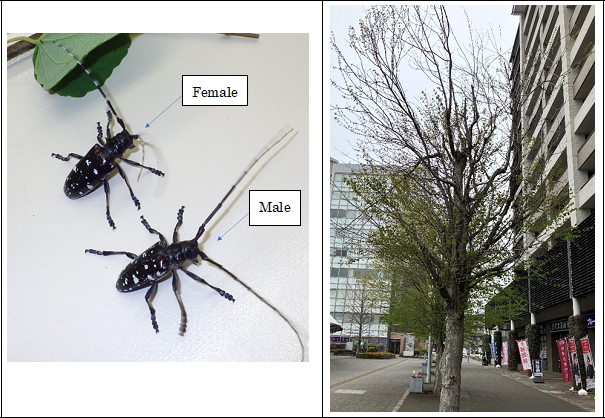The invasion of alien species Asian longhorned beetle (ALB) has been reported in some prefectures of Japan, where it has caused substantial damage especially to street trees such as katsura. Overseas, ALB has reported to damage Rosaceae fruit species including apple. Therefore, to evaluate the risk of infestation of ALB to Japanese fruit trees, we used cut branches of Japanese major Rosaceae fruit trees (apple, Japanese pear, peach, Japanese plum, and cherry) and preferred host katsura tree and conducted laboratory assays. We determined if the ALB adult is "attracted" to the odor of the branches, as well as its "feeding preference" and "oviposition preference" among them. It was revealed that all tested fruit species had lower attractiveness and feeding preference than katsura. It is expected to be a tool to obtain basic information for determining the possibility of infestation by invasive alien species.
Overview
The ALB (Fig.1 left) is known as a pest that causes severe damage to trees and is listed as one of the "100 Worst Invasive Alien Species in the World" by the International Union for Conservation of Nature and Natural Resources (IUCN). Since its occurrence in Japan was confirmed in 2020, its damage has spread to 14 prefectures, and it was designated as a specified invasive species in September 2023. This species is a boring pest of trees, and its larvae feed under the bark, causing death of host trees in severe cases (Fig.1 right). The host range of this species is very wide, and in Japan tree damage has been reported in host plant genus such as Cercidiphyllum, Ulmus, Acer, and Salix (katsura, autumn elm, horse chestnut, willow, etc.). Overseas, however, there have been reports about the damage to apple trees of the Rosaceae family.
Therefore, NARO conducted lab assays to clarify the possibility of ALB infestation of widely cultivated fruit trees in Japan such as apple, Japanese pear, peach, Japanese plum, and cherry trees. In the experiments, attraction to the odor of fruit tree branches, feeding preference, and oviposition preference were compared with those of the preferred host, katsura tree. In terms of attraction to the scent of fruit tree branches, adult males were attracted to cherry and pear branches, but adult females responsible for egg-laying were not attracted to the odor of any of the branches. In terms of feeding preference, feeding was observed on all fruit tree branches, but the consumed area was small, and the preference was significantly lower than that of katsura branches. In terms of oviposition preference, the preference for pear branches was similar to that of katsura branches, but the preference for other fruit tree branches was significantly lower than katsura branches. This species had low attractant and feeding preferences, even on tree species with high oviposition preference.

Fig.1: Adult Asian longhorn beetles (left) and a katsura tree
with the withered upper part damaged by this species (right)
Budget:
A grant (JPJ007097) from the Project of the Bio-oriented Technology Research Advancement Institution (Research program on development of innovative technology 04015C1)
Publication
Hiroe YASUI, Nao FUJIWARA-TSUJII, Soichi KUGIMIYA, Kazuki SHIBUYA, Koji MISHIRO, and Nami UECHI (2024) Anoplophora glabripennis, an invasive longhorned beetle, has the potential to damage fruit trees in Japan. Scientific Reports 14:12708 https://doi.org/10.1038/s41598-024-63548-0
For Inquiries
Contact: https://www.naro.go.jp/english/inquiry/index.html




